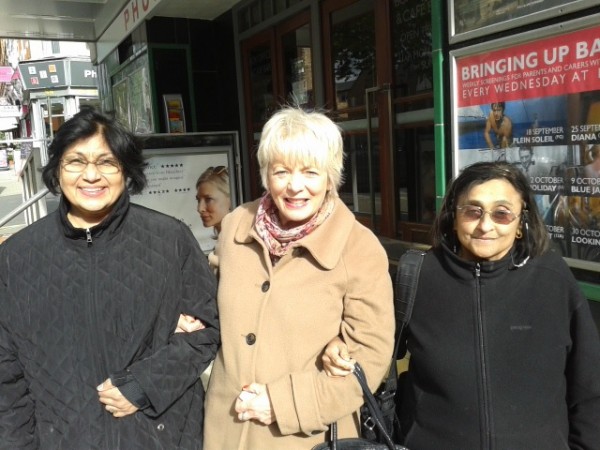Jane Austen’s novel Pride and Prejudice (1813) and Gurinder Chadha’s film Bride and Prejudice (2004) are not only racially different but also two centuries apart, from the days of Britain’s pre-Victorian control of India to its current multicultural diversity. Although representative of their times, Austen and Chadha share their British citizenship, comfortable backgrounds, heterosexual worlds, pioneering female creativity, and good-humored satire. Understandably, each deals largely with the culture and social class with which she is familiar although, as Carol Dole and Courtney Duchene point out, their themes coincide regarding “prudential marriages, class consciousness, and sexual restraint.” The moral fiber, and especially the financial security of the prospective heroes, is also a must. Pride and Prejudice’s tongue-in-cheek opening sentence about “a single man in possession of a good fortune” is universally appreciated, the Anglicanism of Austen’s main characters, an unspoken given. While sharing Austen’s nationality and urbane wit, as an Indo-Kenyan immigrant, Chadha imbues her film with a focus important to her as a Punjabi Sikh: Bride and Prejudice opens with a panorama of the awe-inspiring Golden Temple of the Sikhs in Amritsar. The question remains: In spite of their many similarities, is Chadha’s tricultural appropriation of Austen’s plot, sacred to purists, a success or an upstart travesty? Do the variations in Chadha’s genre, characters, and settings despoil or enlarge the sacred text? I respond as an Indo-American, with a foot in both Eastern and Western cultures.
Austen’s nationally homogeneous and deliberately contained Pride and Prejudice canvas (Longbourn, Meryton, and Netherfield; London; Hunsford and Rosings; Brighton; Derbyshire and Pemberley) parallels her own geographically contained life. Her two principal couples, namely Elizabeth Bennet and Fitzwilliam Darcy and Jane Bennet and Charles Bingley, are all members of the gentry (Bingley aspiring to an estate that will cancel the social demerits of his father’s background in trade). In contrast, Chadha’s broad international cast includes well-off Punjabi Indians, successful Non-resident Indians (NRIs) from Britain and the States, a lower-class English backpacker, and a wealthy Californian hotelier, who variously jet-set among Amritsar (um-rit-ser), home of the Punjabi Bakshi family (buck-shee); beach-haven Goa; and the Western metropolises of London and Los Angeles. This sprawling canvas is not unrealistic: such intercontinental trips are quite common among first-generation diasporic immigrants. The international settings also echo Chadha’s own multicultural life: she is Indo-Kenyan-British while her husband and cowriter for the film, Paul Mayeda Berges, is Japanese American. The couple in Chadha’s subplot, Jaya Bakshi and the NRI barrister Balraj, are both upper-middle-class Punjabi Indians, although of different nationalities. However, Chadha expands her Indo-Western canvas to focus on an international interracial main couple, the Indian Lalita and the rich white American Will (Fitzwilliam) Darcy. Therein lies the rub. Finding the film an upstart ethnic travesty, essentialist or racist critics cannot stomach Chadha’s Indianizing/despoiling the sacred text of Pride and Prejudice with a multiracial canvas.
Although I am citing what might appear academically inconsequential sources, in the contemporary American climate of racial anxiety for various ethnicities, they are views that an Indo-American cannot ignore. Frank Swietek dismisses Bride and Prejudice as “neither Eastern fish nor Western fowl.” More tellingly, Michelle Thomas disapproves of the miscegenation in casting a white American hero against an Indian heroine: Since Austen’s Darcy and Elizabeth are of the same race, culture, and class, she comments, “surely it would make more sense for him to be a wealthy Indian?” Swietek’s and Thomas’s attitudes embody what Edward Said termed “Orientalism,” the Western demotion of Asian cultures to The Other as lowly, quaint, inherently inferior. John Hutnyk, Academic Director of the Centre for Cultural Studies at Goldsmiths, University of London, from 2004–2014, cites Indo-American Homi Bhabha’s exposure of those who see hybridity as “heresy.” Hybridity is “sometimes taken to imply a weakening of a supposedly, once pure culture [or canon]. It is this myth of purity that belongs to the essentialist nationalisms and chauvinisms that are arraigned against the hybrid, diasporic and migrant” (Hutnyk). Thus, Chadha’s supposedly unseemly postcolonial, mimetic re-visioning of Austen’s setting, plot, and character from the Indic periphery to the center becomes one of the main objections to the film, even among some generally respected sources.
Manohla Dargis begins her 2005 review for the New York Times with an Orientalist insult: “The pitch meeting for . . . Bride and Prejudice must have been a killer: Jane Austen’s novel Pride and Prejudice—you know, the dead chick that wrote that Gwyneth Paltrow movie Enya, Emma, whatever—done like a Bollywood musical, only shorter.” Unsurprisingly, she dismisses (or just disses) Bride and Prejudice as “multiplex multiculturalism,” “rife with cliché” and with “worse production values than Hollywood,” “a load of sanctimonious political correctness,” “an unfortunate absence of discerning filmmaking talent,” the “kitsch” of “Ms. Chadha’s attempt to pay homage to Bollywood,” through which she “manages to make hash of a classic of literature.” Actual specifications might have given substance to her diatribe. The review says rather more about Dargis herself, nor does it seem very different from the attitudes of Swietek and Thomas. Like The New York Times’s Dargis, Peter Bradshaw of The Guardian has equally panned the movie. He finds it guilty of “parochialness and shallowness, vast new acres of unreflecting naivety. . . . All the subtlety, all the light and shade . . . have been merrily chucked overboard, as if Chadha can't see a nuance without giving it the heave-ho.”
In spite of anticipating such disapproval even from her own essentialist British peers, creating a multicultural film “inspired by Jane Austen,” as Chadha and Berges put it, seems to have proved a delightful romp for Chadha. Perhaps that is why, although her characters span half the world and three nationalities, she cites her expected audience as Indians at home and NRIs abroad, knowing that her nuances would especially resonate with us. In an interview with Jan Lisa Huttner, Chadha explained some of her hybrid choices regarding the film as well as its intended audience. Neither Eurocentric nor Indocentric, she “operate[d] in [a] global cultural paradigm.” Wanting her theme to reach “the Diasporic, cosmopolitan, global audience around the world,” she chose “a story they’re going to be familiar with” as well as one that fits “contemporary Indian society.” Thus, while maintaining Austen’s genial satire, Chadha took the bold step of supplementing the genteel novel’s romantic story with the vigorous song-and-dance requirements of a Bollywood musical, and, rather extravagantly, included international color with a beach rave party in Goa with Ashanti at the mike and an African American gospel choir on a Los Angeles beach. I must admit that at my initial viewing of the film, the purist in me recoiled at the movie’s “excesses.” At the third viewing, I rather liked some of the songs and merely grinned at Chadha’s Whitmanesque “I am large, I contain multitudes” expansiveness. After all, she had not set out to create an artsy film. Whatever the various degrees of disparagement, targeting a wide, popular audience paid off as, according to Chadha, the film topped the charts in India and Britain (Huttner).
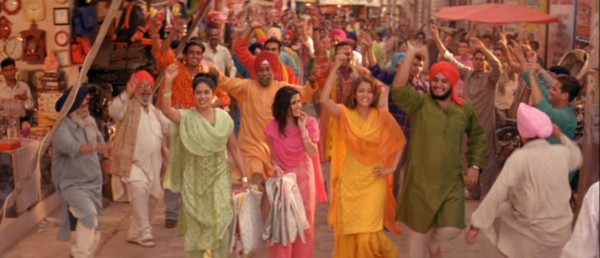
Bollywood dance with Sikhs in the Amritsar bazaar. © 2004 Pathé Pictures
(Click here to see a larger version.)
On the issue of language, Austen naturally used English for her novel; as a Briton, so did Chadha. Since her characters and audience were multinational and India is multilingual with its thirty-two distinct languages, it was imperative that Chadha use English as the film’s medium. English in Bride and Prejudice is crucial because organic: its global cast of characters—Indian upper-middle-class families, Non-resident Indians, the English, and Americans—must be able to communicate in a common language to move the plot forward. Moreover, although Hindi is India’s national language, English is generally the common language among college-educated Indians, within or across states, since most states have their own distinct language and script. (Imagine needing French in Ohio, German in Indiana, and Greek, with its different script, in Virginia.) Each member of Chadha’s Indian cast speaks Hindi and English, but their mother tongues are diverse, hailing as they do from Kannada (one), Bengal (one), Maharashtra (three, including a Mumbai Muslim), and Kashmir (one), to cite a few. This perhaps tedious list aside, Chadha’s diasporic background frees her of the dilemma postcolonial Asian and African writers in the home country have sometimes faced: whether to use a vernacular language or English, the language of their erstwhile colonizers.
As early as 1938, in his foreword to Kanthapura, a notable pre-Independence novel, Raja Rao had explained the position of Anglophone Indians:
One has to convey in a language that is not one’s own the spirit that is one’s own. . . . English is not really an alien language to us. It is the language of our intellectual make-up . . . but not of our emotional make-up. . . . We cannot write like the English. We should not. We can write only as Indians. We have grown to look at the large world as part of us. (1301)
At the other end of the spectrum, while agreeing that we must remake English “for our own purposes,” Sir Salman Rushdie, the Indo-British American novelist, points out that unlike in the home country, the British (or diasporic) Indian does not have the option of rejecting the language, for, “as far as Indo-British fiction is concerned, its [very] existence changes the ballgame” (1310–11). Comfortable with her choice of language, characterization, and a vaster canvas, Chadha has put her diasporic stamp on Austen’s novel without attempting BBC or PBS fidelity.
Chadha made another bold choice that proved judicious in terms of profits. This was to select the Indian superstar and Miss World 1994, Aishwarya Rai, to play Elizabeth Bennet, for, although voted by a 2005 internet poll as the “world’s most beautiful woman” (Armstrong), Rai had never acted in an English film before. Instead of reviewing Bride and Prejudice with the critical acumen he uses for the Pride & Prejudice film starring Keira Knightley, Roger Ebert’s review of Bride and Prejudice speaks in generalities about Bollywood, summarizes the plot, at one point calls Darcy “Darby,” and, in sexist detail, expatiates on Rai’s looks: “Recently described by at least one film critic (me), she is not only the first but also the second most beautiful woman in the world. . . . What a smile. What eyes.” The review concludes: “Even the most strenuous dances are intercut with perfectly composed closeups of Aishwarya Rai, never sweaty, never short of breath. What a smile. Did I say that?” A review of her acting abilities would have helped—and been more respectful.
Rai is a talented actress and certainly a box-office draw (in at least three Indian languages). She made an unfortunate choice, however, regarding her role in Bride and Prejudice. In order not to be led by Austen’s portrayal of Elizabeth, she avoided reading the novel before acting in the movie (Gill). If she had, she would have realized that Lizzy, sharing in what Austen described as the novel’s “light & bright & sparkling” character (4 February 1813), is not only outspoken in her opinions but also charmingly good natured. Thus, while Rai herself is lovely and her character witty, her portrayal unfortunately lacks Lizzy’s redeeming ability to laugh at herself and her ultimate self-knowledge.
Otherwise, the immigrant’s diasporic or “chutney culture,” as Shauna Singh Baldwin aptly calls it, is especially well translated into Bride and Prejudice’s Indian characters. Both Austen and the opinionated, marriage-obsessed Mrs. Bakshi/Bennet agree on the necessity of a good income in marriage, through either a woman’s dowry (like Kitty King’s) or a man’s wealth. An Indian in tune with her century, Mrs. Bakshi scours marriage.com (shaadi.com), but, as Linda Troost and Sayre Greenfield point out, she is well aware that the family income cannot cover four dowries (however illegal), so her daughters might need to work after marriage. Overriding her soft-spoken spouse, Mrs. Bakshi volubly seeks rich expatriate husbands for the older two of her four chaste daughters (Kitty Bennet is made redundant): the gentle, pretty Jaya (Jane); the feisty, intelligent, and lovelier heroine Lalita (Elizabeth); the attention-seeking Maya (Mary); and the Wickham-chasing flirt Lakhi/Lucky (Lydia).
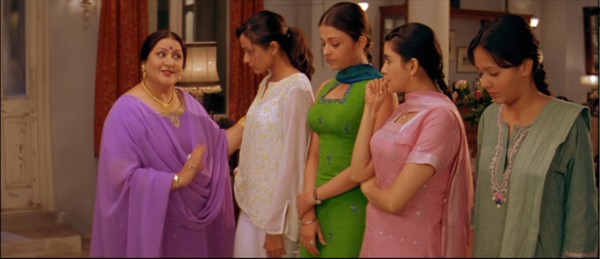
Mrs. Bakshi’s advice to Lalita: Now don’t act too intelligent!
From Left: Jaya, Lalita, Maya, Lucky. © 2004 Pathé Pictures
Chadha’s characterization of Elizabeth/Lalita’s father is more positive than Austen’s; veteran actor Anupam Kher makes for the quintessential genial and witty father, a working farm owner who, along with Lalita, keeps meticulous records of their income, unlike Mr. Bennet. In general, Chadha’s satire is more genial than Austen’s clear-eyed exposure of the shortcomings of Mr. and Mrs. Bennet, Mary, Lydia, and Mr. Collins. Thus Maya, as Troost and Greenfield argue, likes to display her interpretive dance skills but, unlike Mary, is not a “righteous prig” (Meghna Kothari is actually a classically trained dancer); the giddy flirt Lucky rues her thoughtless tryst with Wickham. Marriage being a given, as far as parents are concerned, Chadha also appealed to Indian values. Troost and Greenfield correctly point out that “for all its globetrotting, the Bakshi family is both a narrative and a moral center” of the film; even the wealthy hero Will Darcy, scion of a broken marriage, declares the superiority of Indian family life. The Bakshis appear to be Punjabi Hindus: the sisters sometimes wear bindis; Mr. Bakshi, Mr. Kohli, and Balraj do not have the uncut hair and turbans traditionally required of Sikh men, and their last names aren’t the more usual Singh.
On the other hand, the three male romantic characters, Darcy, Balraj, and Wickham, are all Westerners or Westernized. Chadha describes Will Darcy as a “handsome American, as opposed to an ugly American, but he has enough attitude to need a good Colonialism/ Imperialism 101 from Lalita” (qtd. in Troost and Greenfield). He is a white, wealthy, workaholic, five-star-hotel magnate, clueless about the “real India” (and played by a New Zealander American) yet interested in an investment in Goa. En route to Goa, he accompanies his Oxonian best friend, the suave British-Indian NRI Balraj, to an Amritsar wedding where the latter is to serve as best man (not that Hindu marriages have a best man). Balraj replaces Bingley as suitor to Jaya while the insolvent rake Wickham is replaced by the backpacking Brit Johnny Wickham, who wins Lalita’s heart in Goa because he appreciates India instead of finding fault with it like Darcy.
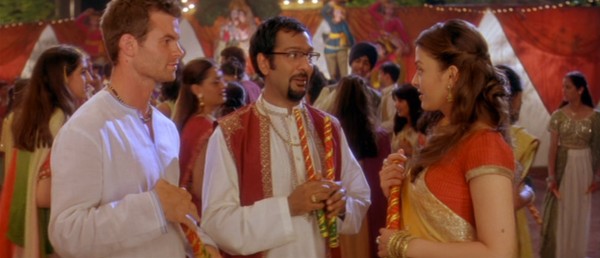
Johnny, Mr. Kohli, Lalita. © 2004 Pathé Pictures
Handsome Darcy, not eligible in the marriage market in the eyes of the giggling, hawk-eyed mamas at the wedding because it’s “too bad” he’s a foreigner, finds Jaya’s younger sister Lalita physically attractive, but not as tractable. But because he is scornful of India and she an Indophile, verbal sparks fly between the two from the start. Both Austen’s and Chadha’s Darcys are snobs, the latter’s Americentric one being what Edward Said terms “Orientalist”: he mocks the exuberant Punjabi dancing at the wedding, ambiguously refuses a second dance with Lalita to get back to his hotel and laptop, irritably wonders how serious business can ever be conducted in such Indian towns with their electric power cuts, and is bemused by the system of arranged marriages (although Lalita herself wants to marry for love).
Perhaps mercifully for Darcy, Lalita has not been privy to his smugly arrogant disparagement of India almost from the airport onwards—he declares Amritsar, with its colorfully depicted crowded streets, dust, cows, rickshaws, and other such stereotypes to be hicksville; he smirkingly wonders if partaking of an appetizer at the posh wedding will give him Delhi-belly; more seriously, later in their hotel, he attempts to dissuade Balraj from forming an attachment to Amritsari Jaya, for, however attractive, she would be less culturally suited to his sophisticated friend than a westernized NRI would. Unlike the modest Bingley, Balraj refuses, instead inviting Jaya and also Lalita (since Mr. Bakshi insists on a chaperone) to spend time with them in beautiful Goa, where Darcy, like Bingley checking out Netherfield as a potential acquisition, wants to acquire a resort.
My memory of the British occupation of India until 1947, as well as the liberation of Goa itself from the Portuguese in 1961 and the banning of the American Coca Cola industry from India for many years thereafter, helps me understand Lalita’s scorn for neo-colonial Westerners, whom she accuses of wanting to profit from India without the botheration of dealing with Indians.
Lalita: I thought we got rid of imperialists like you!
Will Darcy: I’m not British, I’m American!
Lalita: Exactly.
Yet Chadha also gives her hero a softer side. Lounging around the hotel pool with his laptop, when derided for his supposed single-minded focus on business, Darcy mildly replies that he’s writing an email to his sister Georgie.
The sparring goes on. Still upset by Darcy’s elitist attitude to India, Lalita continues to upbraid him for his business acquisitiveness. She vehemently reminds him about the real India, no doubt meaning the lower-middle-class dwellers in the Amritsar-bazaar locality and the impoverished rural and urban poor. In fact, it is partly because low-budget traveler Johnny Wickham, whom she meets in Goa, proclaims that “if you have money, you never get to see the real India” that Lalita begins to fall for him. Lalita and Wickham both talk the same talk, believing in their own sincerity. Yet, coming from a well-off, upper-middle-class background, Lalita appears ignorant of the irony of living in an area akin to what Martiniquan philosopher Frantz Fanon called the erstwhile ruling race’s comfortable, whites-only settlements, while the lower classes inhabit the areas of the lowly Other (130–32). Chadha quietly exposes Lalita’s socioeconomic blind spots although aware that focus on family finances is important to both her own and Austen’s plots.
There has been another suitor in the offing back in Amritsar—the NRI Mr. Kohli. I differ from Western critics in my assessment of the characterization of the Indo-American suitor. Mary Chan finds him “perhaps the most undesirable Collins” among the many Pride and Prejudice movie offshoots, a “flat” character who “amplifies all of Mr. Collins’s worst qualities,” depicted without the “soften[ing]” of most of the other Collins avatars (my term). Her disregard extends to her continual misspelling of his name as Kholi. Troost and Greenfield accuse Mr. Kohli of “combin[ing] the worst aspects of American and Indian attitudes—the materialism of one and the sexism of the other.” (I’ve come across Indians and Americans who are both materialistic and sexist.)
Troost and Greenfield also find Mr. Kohli comic, as I do. Although I modified my opinion after a recent viewing of the film, I initially found the pseudo-American green-card-holder tremendously funny, a caricatured but very recognizable expat type, and yet also, on several levels, more complex—and nicer—than Austen’s Mr. Collins or than the Mr. Kohli seen through Chan’s scathing assessment. On the comic front, the gauche, nouveau-riche Mr. Kohli appears a laughable hybrid with his Hinglish (vernacular Hindi/English) accent; trite, self-satisfied adages (“No life, without wife!”); braying laugh; and confused borderland values. Yet, although snobby English-medium-educated NRIs like me feel superior to him, he is no different from us in being one of the many educated Indians emigrating to the U.S. for postgraduate studies, better standards of living, and higher salaries. It is Kohli’s lack of sophistication that makes him brag about his five-bedroom, three-bathroom house in L.A., to him happy proof that he is an Amrikan [um-ree-kan] success.
Yet, Mr. Kohli is insular enough to seek a bride from India because he fears potential Indo-Americans as outspoken, career oriented, and “even . . . The Lesbian!”). Feminist though I am, I am Indian enough to find Chadha’s stereotypical but not unkind portrayal to be comically true-to-life because, although overblown, it seems to merely expose Kohli’s pretentions to being au courant with Western liberal values, even (to him), risqué Amrikan ones. His attitude to life seems one of unselfconscious, if harmless, gusto, seen also in his exercising and eating habits. A bachelor no doubt cooking for himself in L.A., he overtly enjoys his authentic Punjabi meal at the Bakshi table. Mary Chan finds his table manners “disgusting”; the more sophisticated sisters find him embarrassingly lowbrow; I smirk at his eating style. We westernized Indians are not quite fair to such familiar “foreign-returned” types; our elitist guffaws here are loudly appreciative of Chadha’s realistic mimicry.
But the quiet subtext is that Chadha’s portrayal also helps a discerning Indian audience to evaluate Jaya and Lalita’s values while not actually condemning them. For me, Mr. Kohli’s Hinglish accent conversely segues into an evaluation of the Bakshi sisters’ stereotypically elitist approval of Balraj, although he too, like Mr. Kohli, is an NRI interested in an Indian wife. I suspect that one of the subconscious reasons the affectionately close Jaya and Lalita unwittingly approve of the pukka English barrister Balraj, rather than pseudo-Amrikan Kohli, is precisely that, as a second-generation, assimilated, Indo-English citizen, the former speaks with an upper-class British accent and lives an anglicized life. While Mr. Kohli’s proposal is vehemently rejected by Lalita, à la Elizabeth, Balraj and Jaya’s mutual interest is encouraged from the start.
And Mr. Kohli’s plus points? In the marriage market, as the wealthy Darcys’ accountant for their posh hotel, he is a good catch for traditional Indian women seeking NRI husbands. More importantly, although he lacks depth, he has a good heart. Unlike the self-serving Mr. Collins, who continues to partake of the Bennets’ hospitality even when he turns his attentions to Charlotte Lucas, the roundly rejected Mr. Kohli immediately leaves the Bakshi premises. Lalita’s good friend Chandra, like Charlotte, accepts Kohli’s offer but with a far different result. Since Chandra wants the Bakshis, including the outspoken Lalita, to attend their wedding in California, Mr. Kohli holds no grudges. Generous in both spirit and purse, he pays fares not only for Chandra’s parents but also Mrs. Bakshi, Jaya, Lalita, and Lucky. He further proves a welcoming host to them in his now-useful five-bedroom, three-bathroom house; and finally, and perhaps most importantly, Chandra confides to Lalita that “he is kind, he really loves me, I love it here” (emphasis mine). This moves me. Chadha has redeemed Mr. Kohli for me; her satire, unlike Austen’s, is ultimately affectionate; he is foolish, perhaps educable, but never mean.
Unlike Mr. Kohli, whose affection for Chandra increases in L.A., a change in continent appears to effect changes in both Balraj and Darcy that complicate the romantic plot. On his home ground, the suave Indo-Brit who had courted Jaya in India, in spite of Will’s efforts at separation, has morphed into an all-too-familiar Indian type, the good son who obeys his parents rather than his heart in his marital choice. Altogether missing from London when the Bakshis take a stopover there en route to L.A., he is dutifully vetting suitable NRI prospects in New York. A more Western-type reversal occurs when his friend Will unexpectedly runs into the Bakshis at Pemberley-Heathrow, waiting for the same flight to L.A. Rekindled interest in Lalita makes him offer his first-class seat to the delighted Mrs. Bakshi; while she happily swills champagne, he sits cheerfully cramped in economy next to Lalita during the eleven-hour flight. Lalita is not amused. But the quality time with her makes Will rethink his erstwhile materialistic values; he has not only been sparring with Lalita in India, it seems but really listening to her.
Most importantly, Will has been moved enough by Lalita’s strictures against his neo-colonial acquisitiveness to veto the hotel venture in Goa, much to his unsuspecting mother’s chagrin. At their posh hotel in Beverly Hills, where the Kohlis’ American wedding is to take place (the wedding having already been formalized in Amritsar to satisfy social propriety, as important to Indians as to Austen), the supercilious Mrs. Darcy/Lady Catherine de Bourgh speaks regretfully to the Bakshis of the failed hotel takeover that aborts her intention to visit India. Her shallow exchange with Lalita makes quite clear where Darcy got his erstwhile acquisitive values:
Mrs. Darcy [with a disparaging look at her son]: Well, if I had a hotel in India, I might have. But with yoga and spices and Deepak Chopra and wonderful Eastern things here, I suppose there is no point in traveling there anymore.
Lalita: People haven’t stopped going to Italy because there’s a Pizza Hut around the corner.
East is East and West is West, yet Chadha shows that both cultures share these values. In the matter of their son’s matrimony, Balraj’s parents as well as Darcy’s mother prefer their own type. Mrs. Darcy prefers the blonde, chic, and wealthy Ann, whose family the Darcys have known for three generations, to an Indian woman from the land there’s no need to visit anymore. But her son is no longer tractable.
On his home ground in L.A./Pemberley, Darcy’s obvious attraction and his changed character make Lalita finally begin to appreciate him. Yet, as in Pride and Prejudice, she cannot forgive him on unwittingly learning from Georgie that he saved a “friend” from marrying the daughter of a “gold-digging” mother. His crimes are two-fold because he’s supposedly treated Wickham badly too.
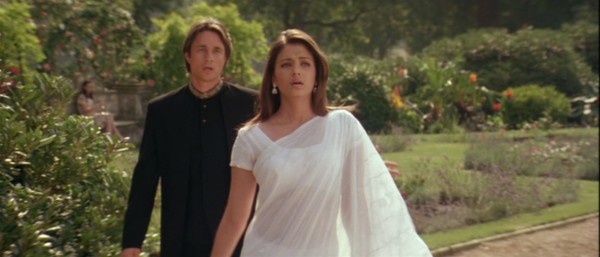
You have “been the means of ruining, perhaps forever, the happiness of a most beloved sister.” (Pride and Prejudice). © 2004 Pathé Pictures
Will follows the Bakshis back to London, this time his love for Lalita forcing him to tell his family secret. Son of their English nanny, Wickham had seduced and impregnated teenaged Georgiana. Although brotherly Darcy had arranged for an abortion, Lalita surely realizes that Georgie’s emotional scars still remain. Understanding Wickham’s true self finally allows Lalita to see that it is Will’s character that has real depth; he is worthy of being loved. Their relationship crystalizes over the Johnny-Lucky overnight tryst that occurs during the Bakshis’ return layover in London. The amoral nature of these two minor characters allows for the final plot complication. Darcy earns the distraught family’s gratitude and Lalita’s love when, facing Johnny in a movie-within-a movie scene, he thrashes the Brit, stalwart Bollywood hero satisfyingly demolishing depraved villain. Perhaps the loving brother in him has avenged his young sister too.
The corollary question of whether Lucky too has lost her virginity is as important to Chadha’s Indian audience as to Austen’s Regency one, as Janeite critics have correctly assessed. Barbara Seeber suggests that Lucky has been more interested in the sights of London and a Bollywood film than in an actual sexual encounter; Troost and Greenfield see her exhibiting “remorse for what she has done, unlike Lydia.” Dole and Duchene point out that Lucky is not forced to marry Wickham in order “to save her [and her family’s] social status” and that Chadha leaves Lucky’s “future choices open and her reputation undamaged.” I disagree. As a middle-class female, if Lucky were back in India and her tryst known, whether or not she has lost her virginity, she would have certainly lost her reputation as well as the chance of a prosperous arranged marriage. The Bakshis, like the Bennets, would experience the social fallout of her disgrace. But Chadha will not allow this problematic ending: Dole and Duchene point out that her interest is in presenting “an upbeat family comedy” and add that Chadha also exonerates Mr. Bakshi (who’s not even in London) from Mr. Bennet’s culpability in permitting redcoat-chasing Lydia’s trip to Brighton. Likewise, Austen saves the Bennets’ reputation through Darcy’s bribing Lydia and Wickham into marriage. The more honest eighteenth-century and Regency novels showcase the cynical reality that if a society woman carefully guarded her reputation, whatever her bedroom shenanigans, she could retain her standing among the bon ton. In India today, although social values among Westernized Indians are being quietly infiltrated by Western sexual mores, I’m quite sure Lucky would not have escaped unscathed.
Finally, here’s a novel perspective on the tryst: what if it has been Johnny who has exercised restraint? Lucky has been flinging herself at him since India; an immature as well as forward teen, she’s had no qualms about spending the night with him. Yet there are three strikes against her: she has a fiercely close-knit family whom it might be dangerous to cross; she lacks the Darcy millions; and, more importantly, she does not share her sister’s loveliness (tolerable, but not handsome enough to tempt him). Wickham is judiciously willing to show her the London Eye but not a good time, yet he gets beaten up anyway.
The movie ends as the novel does, with predictable Indian color (pun intended). Amor vincit omnia. The glass slipper fits; Darcy apologizes to Balraj for his former interference; the latter and Jaya get joyously engaged, as does the main couple. All his ugly Americanism now washed off, the changed Darcy is described by Troost and Greenfield in terms of cultural synthesis and respect: “He has not gone native [I shudder at the expression], but he has learnt to combine east and west successfully.” Lalita too “exemplifies an ideal fusion of eastern and western values.”
For the circle to be complete, the weddings, lavish and spectacular, must of course take place in Amritsar; the good-looking couples, both dressed in gorgeously expensive Indian marriage garb, depart, it appears, after a Hindu wedding, on richly decorated elephants, rather than on the white horses traditional in Punjabi weddings. Curtain time. The movie ends with the two pretty, chaste older Bakshi sisters securing rich and handsome young husbands, valued for their character rather than wealth (although it is probably true that neither sister would have considered a good man from the Amritsar bazaar husband material). Over two centuries ago, critiquing the anonymous The Mental Triumph: A Sentimental Tale (1789) for the Analytical Review, Mary Wollstonecraft had accepted such traditional happy endings as a norm in romantic novels but tellingly wondered: “But why is virtue to be always rewarded with a coach and six?” (216). Right on, Wollstonecraft, ma sembable, ma soeur.
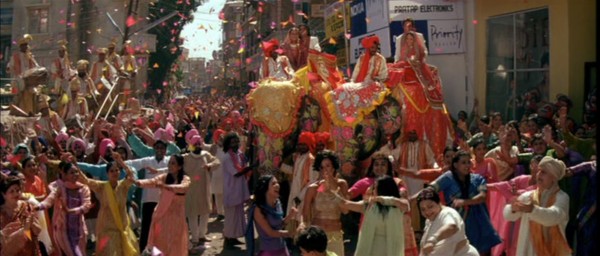
Showcasing Punjabi processional wedding-dancing. (Picture includes 3 hijdas, an ancient, ubiquitous, sari-wearing transgender clan. India officially recognizes three sexes.)
© 2004 Pathé Pictures
(Click here to see a larger version.)
There is only one serious, if elided, note in an otherwise romping Bride and Prejudice. Even a century later, it is hard for Indians to forget colonial brutality. Chadha is fiercely Indian and Sikh in one historical respect. Twice, a sign in the film shows the Bakshi residence to be on Udham Singh Road, named after the Indian martyr hanged for killing General Dyer, mass murderer in 1919 of a peaceful spiritual gathering, including Sikh women and children, in Amritsar’s Jallianwala Baagh (Singh Baldwin). The official British toll was 488 dead and over 1,200 injured—a subtext too somber for Austen’s apolitical comedy of manners, redcoats notwithstanding. Is Chadha, on one level, quietly paying back old scores? Or has she, with an arrogance ill befitting a brown artist, sinned even further in attempting to colonize Austen and thereby pollute the shades of Pemberley? Is her re-visioning tampering?
If we object to tampering with the sacred text of Pride and Prejudice, mustn’t we put aside all contemporary Austen offshoots and remakes? Better to acknowledge, and welcome, the contemporary global fluidity of earlier historical, geographical, racial, and postcolonial boundaries. On the question of whether, and how, hitherto-colonized writers should rework canonical originals, John Marx, siding with the Indian Michael Madhusudan Dutt’s borrowing from Milton, states: “To appropriate Western canonical literature one must first rewrite it, dismantle it, and come to see it less as an inviolate whole than as a collection of parts suitable for recycling” (89). Chadha neither colonizes Austen nor tarnishes her. Actually, in the entirely different film medium of our times, if admittedly on an elephantine canvas, she joins our beloved author as a clever, pioneering, tongue-in-cheek fellow feminist with a love of irony, wit, gentle satire, and sheer talent. I think that Austen, after a longish considered pause, might have quietly chuckled with sister Cassandra over Chadha’s Rabelaisian recycling.
